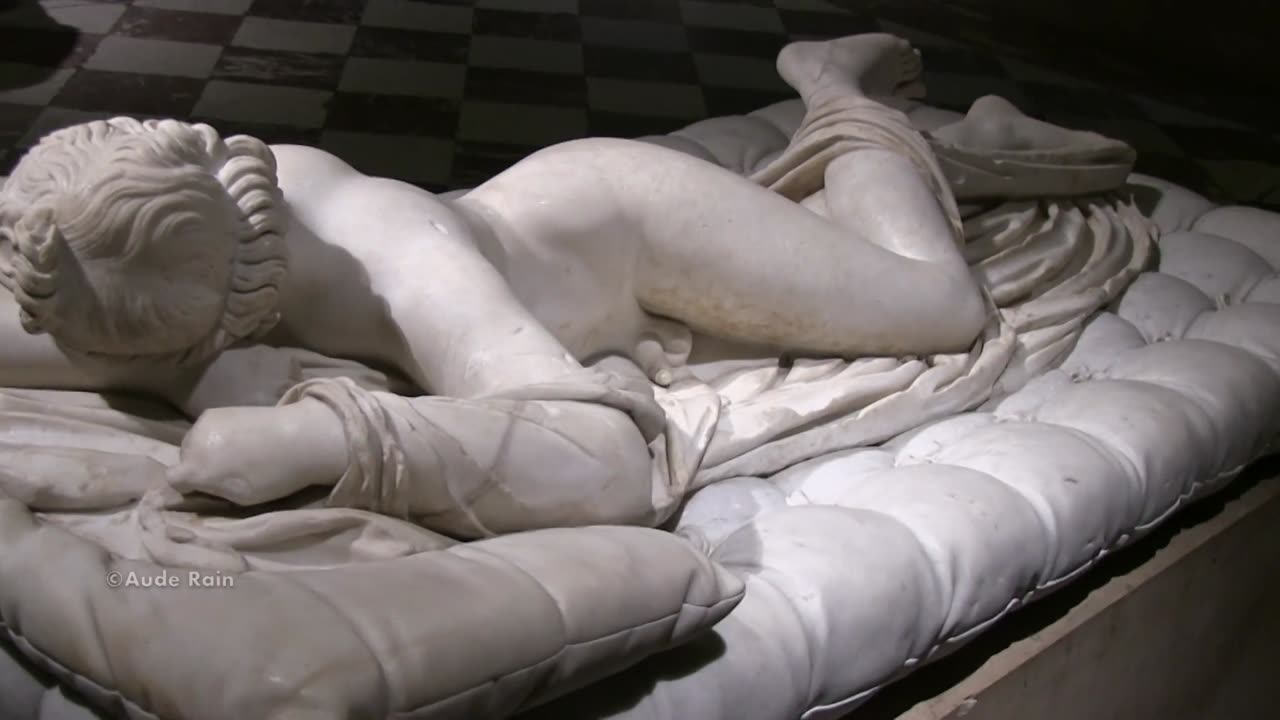Premium Only Content

Sleeping Hermaphroditus - Musée du Louvre & Galleria Borghese
The two copies of "Sleeping Hermaphroditus" filmed in Paris and in Rome.
"This work is a Roman copy that was probably inspired by a Greek original of the 2nd century BC. Pliny the Elder cites a Hermaphroditus Nobilis by Polykles (Natural History, XXXIV, 80), but since he does not describe it, one hesitates to compare it with this sleeping Hermaphroditos. The subject reflects the taste for languid nudes, surprise effects, and theatricality, all of which were prized in the late Hellenistic period. The work is designed to be viewed in two stages. First impressions are of a gracious and sensuous body that leads one to think that the figure is a female nude in the Hellenistic tradition; this effect is heightened here by the sinuousness of the pose. The other side of the statue then brings a surprise, revealing the figure's androgynous nature by means of the crudest realism. This effect of contrast and ambiguity, indeed this taste for the strange that plays with the viewer's emotions, is the result of the theatricality of some Hellenistic art. This utopian combination of two sexes is sometimes interpreted as a half-playful, half-erotic creation, designed to illustrate Platonic and more general philosophical reflections on love." Marie -Bénédicte Astier, Musée du Louvre
"Discovered in Rome near the Baths of Diocletian in 1608, this statue was one of the most admired masterpieces of the Borghese Collection in the 17th and 18th centuries. In 1619, Cardinal Scipione Borghese commissioned the Baroque Italian sculptor Bernini to carve the mattress on which the ancient marble now lies. In the same year, David Larique worked on the restoration of the figure of Hermaphroditos. The work came to the Louvre after it had been bought, together with the rest of the Borghese Collection, by Napoleon I from his brother-in-law, Prince Camillo Borghese. Although the figure of Hermaphroditos in the Louvre is the best known, three other versions of the ancient statue have sometimes been compared with it: that of Velletri (also in the Louvre), that in the Uffizi in Florence, and a third version in the Villa Borghese in Rome."
"There is nothing improper in this work, but it still intrigues the viewer. Hermaphroditos, son of Hermes and Aphrodite, had rejected the advances of the nymph Salmacis. Unable to resign herself to this rejection, Salmacis persuaded Zeus to merge their two bodies forever, hence the strange union producing one bisexed being with male sexual organs and the voluptuous curves of a woman. Stretched out in erotic abandon on the mattress provided by Bernini, the figure sleeps. Yet Hermaphroditos has only fallen half asleep: the twisting pose of the body and the tension apparent down to the slightly raised left foot are indicative of a dream state.
An embodiment of Hellenistic taste"
"Son nom provient de celui de ses parents : Hermaphrodite, fils d’Hermès et d’Aphrodite. Son lieu de naissance est incertain, mais celui où il passa ses premières années nous est connu : les forêts du mont Ida, en Phrygie, où il fut élevé par les Nymphes. Une vie normale, comme celle de tous les enfants, jusqu’au jour où, parvenu à l’âge de quinze ans, il décide de partir à la découverte du monde, sillonnant l’Asie mineure au cours d’un voyage qui le conduira jusqu’en Carie, sur les rives d’un lac magnifique. Là, dans ce lac, habite Salmacis, une nymphe plutôt entreprenante qui en voyant Hermaphrodite – devenu, en grandissant, d’une beauté extraordinaire – en tombe éperdument amoureuse et cherche par tous les moyens à le séduire. En vain : Hermaphrodite repousse ses avances, mais Salmacis ne renonce pas. Plus que jamais décidée à atteindre son objectif, elle feint de se résigner et attend l’occasion propice, qui se présentera finalement le jour où Hermaphrodite, après s’être déshabillé, s’élance dans les eaux du lac. La nymphe, qui n’attendait que cela, se jette sur lui, l’enlace de toutes ses forces en une étreinte dont Hermaphrodite ne parvient pas à se libérer. Mais une étreinte momentanée ne suffit pas à la nymphe amoureuse ; elle désire que son corps ne puisse plus jamais se séparer de celui du jeune homme. Ce qu’elle demandera aux dieux, qui le lui accorderont. Les deux êtres resteront unis pour toujours en un être nouveau, à la fois homme et femme. Le récit se trouve dans Les Métamorphoses, d'Ovide." https://www.cairn.info/revue-diogene-...
-
 LIVE
LIVE
Price of Reason
8 hours agoHollywood Celebrities FLEE the US After Trump Win! Wicked Movie Review! Gaming Journos MAD at Elon!
3,473 watching -
 DVR
DVR
Alex Zedra
3 hours agoLIVE! Last Map on The Escape: SCARY GAME.
37.2K2 -
 1:14:07
1:14:07
Glenn Greenwald
8 hours agoComedian Dave Smith On Trump's Picks, Israel, Ukraine, and More | SYSTEM UPDATE #370
138K146 -
 1:09:07
1:09:07
Donald Trump Jr.
11 hours agoBreaking News on Latest Cabinet Picks, Plus Behind the Scenes at SpaceX & Darren Beattie Joins | TRIGGERED Ep.193
179K522 -
 1:42:43
1:42:43
Roseanne Barr
7 hours ago $47.22 earnedGod Won, F*ck You | The Roseanne Barr Podcast #75
73.3K160 -
 2:08:38
2:08:38
Slightly Offensive
8 hours ago $14.01 earnedDEEP STATE WINS?! Matt Gaetz OUSTED as AG & Russia ESCALATES War | Guest: The Lectern Guy
43.5K17 -
 1:47:36
1:47:36
Precision Rifle Network
7 hours agoS3E8 Guns & Grub - the craziness continues
40.6K2 -
 41:37
41:37
Kimberly Guilfoyle
9 hours agoPresident Trump Making all the Right Moves,Live with Border Union Chief Paul Perez & Lawyer Steve Baric | Ep. 176
135K37 -
 19:38
19:38
Neil McCoy-Ward
12 hours agoMASS LAYOFFS Have Started... (How To Protect Your Income)
40.9K7 -
 46:21
46:21
PMG
1 day ago $2.76 earned"Venezuelan Gang in 16 States, Animal Testing Crackdown, & Trump’s Nominee Battle"
28.1K9